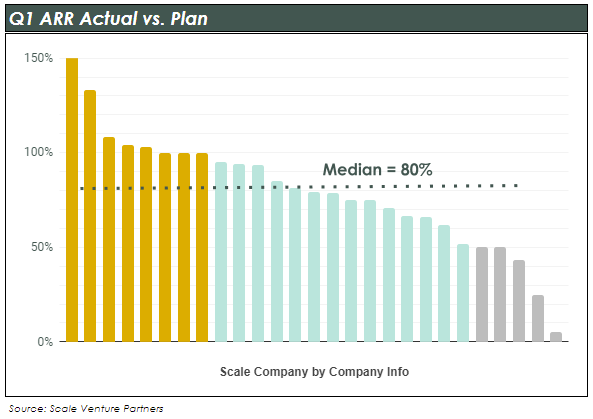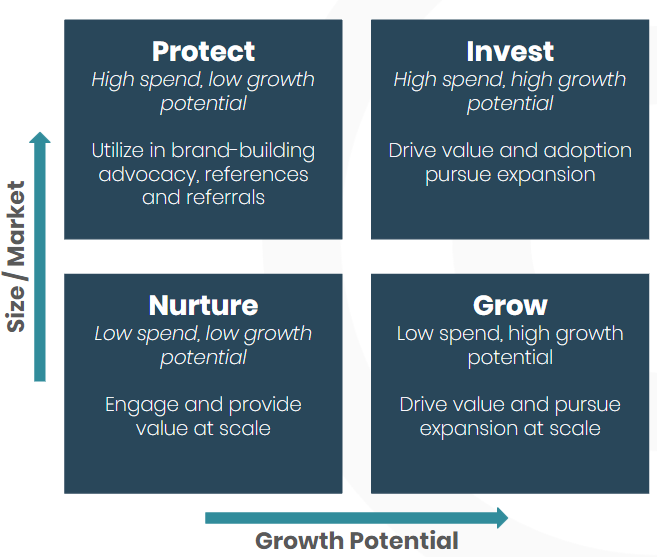No one in SaaS will soon forget March 31, 2020. The last day of a turbulent 1Q20 was one for the record books. As the dust settled, some surprises became apparent. Scale reported at the time that the biggest surprise was the diversity of outcomes for individual enterprise software startups.
This article is the second collaboration between Scale and Customer Imperative. Our first article discussed the many reasons to build Customer Success operations early in a startup’s growth.
Scale analyzed a 27-company sample of our enterprise SaaS portfolio to figure out the impact to each individual company’s performance relative to their pre-downturn ARR targets. Here’s what we found:

As you can see, median Q1 ARR as a percentage of plan was 80%. But the real story is the range of outcomes: from 5% to 150% of New ARR plan. That in a nutshell illustrates the state of SaaS right now. It’s also a good reminder of the situation that your customers find themselves in, whether they’re large enterprises or SMB.
So what should sales and customer success leaders do to adapt customer retention strategies to the many different situations your customers are in?
During a recent CS Leadership Office Hours meeting, one participant shared a very succinct answer to that question: “Your customers will remember who was a partner throughout this experience.” To make sure you’re on the right side of that ledger, you need to understand and quantify the circumstances of every one of your customers.
Customer Success in 2020 Is a New Ball Game
Let’s start in familiar pre-COVID territory. Each customer in your base would fit into one and only one quadrant in a matrix defined by two factors: market size and growth potential. Customer retention activities would vary across these categories.

Right now the growth potential axis is a lot shorter than it was going into 2020. Customers that slotted into the Invest and Grow buckets are now crowding into the Protect and Nurture buckets. This has a cascade of implications for your customer retention programs:
- CS resources formerly focused on driving expansion need to shift to retention work.
- Nurture and advocacy programs need to be adapted to the expanded diversity of customers now in these categories.
- You need to rethink past decisions about the use of technology vs. personal interaction. In what areas can you continue to rely on marketing automation and nurture campaigns versus replacing those activities with person-to-person outreach?
- Many team members are shifting into unfamiliar roles, requiring training and support to learn new processes. From their perspectives, it’s almost like starting over. Mix in the impact of RIFs and this is a very delicate situation requiring careful management and communication.
- You’re going to need to adjust performance metrics and compensation models to restructure incentives to your new focus areas.
So how do you get started segmenting your base along customer health?
Overview of Thriving-Striving-Surviving
Start by conducting a segmentation by health exercise for the purpose of triage and prioritization. Just as the SaaS software universe is experiencing widely divergent outcomes right now, so too are your customers. This implies that within any given industry segment, for example, you might have a large customer doing well while numerous smaller customers are fighting for their lives. In another vertical, the situation might be the opposite.
Think of customer health as a new (and temporary) “super-segment” that cuts across all traditional segments. A simple framework like this is all that’s needed:
- Thriving: the customer’s business is healthy
- Striving: the customer is staying afloat but under downward pressure
- Surviving: the customer’s business is floundering
Here’s what to look for when slotting customers into one of the categories.
Thriving
Description: These customers are doing well so far, though in most cases that means their business is “not down much”.
CS focus: Assume that expansion opportunities are few and far between for now, but you can still make it very easy for them to up their business with you when the time is right.
Striving
Description: This is the neutral case. These customers may not be overly impacted now, but there’s unlikely to be room to expand for some time.
CS focus: Prioritize retention and set yourself up for expansion later by focusing on the relationship now. Remember the quote above about being the customer’s partner.
Surviving
Description: These customers are at risk of churning because their business is down considerably and they must cut costs.
CS focus: Identify them early enough to take action before they churn. Consider concessions to keep them on the platform at a lower cost on the theory that it is better and cheaper to keep a customer than need to win them back later. Find non-engagement value-driven activities like a data-driven report on a topic of interest, sent via email to be supportive from a distance.
Now let’s look at exactly how to go about this segmentation exercise.
Five Action Steps
Step 1. Segment customers by health using the Thriving/Striving/Surviving framework. To begin with, let your customers’ industry guide your initial segmentation. We know that retail, hospitality, travel and leisure have been inordinately impacted. While other industries, such as collaboration, communications, and logistics are booming. Ask each CSM to take their group of customers and do a first pass at tagging each customer by Thriving-Striving-Surviving.
The goal at the outset isn’t perfection. It’s important to get started right away and iterate over time. Don’t waste time designing the perfect segmentation framework when you could be using that time to actually run the exercise. Generally speaking, coming out of Step 1 we want to have a hypothesized forecast and then we are validating with CSM outreach.
Step 2. Build a communication framework for your CSMs in each segment. Create and distribute to your CSMs guidelines on what to say, how to approach conversations, and ultimately your company’s position on contract re-negotiation. You won’t be able to plan for all sessions. So just make sure you feel like you can give your team the basics to have a valuable call with each client.
Step 3. CSMs execute the intended outreach 1:1 with customers. It is important to make this outreach personal. Prioritize their list of accounts based on health segment and its risk assessment to spread out work and avoid getting flooded. This is a time to sacrifice efficiency for personalization. Some companies are making efforts to personally contact every single customer, large and small, and we recommend this approach. This segmented approach will help you avoid overwhelming your team and hindering effective follow-up on those interactions.
Step 4. Build an account health score for each account. Use the validated health segmentation data to populate updated revenue and renewal forecasts. The trick is coming up with a plan that makes sense for your company to translate unstructured CSM notes (“we’re doing fine” or “it’s rough right now”) into a structured account health score. Consider prioritizing three factors: Relationship Quality, Business Outlook, and Product Usage.
Step 5. Debrief as a team, share insights, update the framework, and keep moving. The learnings being collected by individual team members need to be shared across the team. Original internal-use content and regular meetings can be very useful here. Team members always perform better when they know their fellow teammates are going through similar things.
Step 6. Collaborate with your CFO and leadership team to build a concession framework. Customers are asking for concessions during this time. Consider what you can do to ease the burden on all of your customers. But you don’t want to respond to each request on a case-by-case basis. Instead, develop a decision system to help everyone on your team stay consistent handling specific customer requests. The framework should include reviewing each request by industry and size, the customer’s validated health score, and when the customer’s next payment or renewal is anticipated. Give priority to those in impacted industries with near-term renewals. This approach prevents you from solving this custom for every request that you receive.
Counter Uncertainty with Data
This is a time of great uncertainty for Sales and Customer Success teams. Factors outside of your direct control have taken the reins. We’ve discussed how to counteract that uncertainty by collecting data about your customers then establishing processes for sharing that data across your organization — and, most importantly, using it to make decisions about where to focus teams and resources.
The good news is that the sky isn’t falling everywhere. A COVID impact scorecard like Thriving, Striving, Surviving can give everyone in your company the insight they need to protect your customer base, add value to your customers, and position your company to thrive as conditions return to normal.
Dale Chang is the Operating Partner at Scale Venture Partners, where he advises portfolio companies on strategies for go-to-market and scaling.
Jay Nathan is Founder and Managing Partner of Customer Imperative, where he and his team help SaaS companies scale revenue by operationalizing customer success.